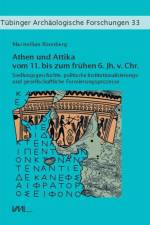von Maximilian Rönnberg
79,80 €
Gängige Narrative zum frühen Athen nehmen eine Phase der "Dunklen Jahrhunderte", eine plötzliche Entstehung der Polis im Zuge der "Renaissance" des 8. Jhs. v.Chr. sowie eine früharchaische "Rezession" an, welche in die vorsolonische Krise führte. Die vorliegende Untersuchung richtet den Blick auf die längerfristigen soziopolitischen Prozesse, um derartige Vorstellungen zu prüfen. Den archäologischen Abschnitten der Arbeit ist ein Kapitel zur historischen Entwicklung Athens bis ins frühe 6. Jh. v.Chr. vorangestellt. Die kritische Bewertung des Zeugniswerts späterer Quellen ermöglicht es, Annahmen eines bereits im 7. Jh. v.Chr. entwickelten athenischen Staats und umfassender solonischer Reformen zu hinterfragen. Dies gibt den Blick auf die sukzessive Zunahme von Staatlichkeit im Laufe der archaischen Epoche frei. Auf Grundlage einer systematischen Zusammenstellung der Befunde wird im Anschluss die Besiedlungsge-schichte Attikas von submykenischer bis in früharchaische Zeit skizziert. Dem Konzept einer von ihrem vermeintlichen Zentrum ausgehenden "Binnenkolonisation" Attikas kann dabei die These langwieriger, kleinteiliger, dezentraler Verdichtungsvorgänge entgegengesetzt werden. Schließlich werden die Nekropolen und die Heiligtümer diachron auf Indizien gesellschaftlicher Transformationsprozesse befragt. In beiden Feldern kann der Untersuchungszeitraum grob in eine Phase der stärkeren gesellschaftlichen Fragmentierung im 11. bis 9. Jh. v.Chr. und eine Periode der wachsenden soziokulturellen Verbindungen ab dem 8. Jh. v.Chr. gegliedert werden, während sich gerade im 7. Jh. v.Chr. eine beginnende Festigung sozialer Prominenzrollen abzeichnet. Zuletzt werden die Einzelergebnisse der Arbeit miteinander in Beziehung gesetzt. Es entsteht das Bild einer zwar ab dem 8. Jh. v.Chr. beschleunigten, doch letztlich kontinuierlichen Entwicklung, innerhalb derer die früharchaische Zeit eine entscheidende Formationsphase darstellt. Die Vorstellung einer "Entstehung" der athenischen Polis im 8. Jh. v.Chr. ist dagegen irreführend.Established narratives of early Athens assume a "Dark Age? phase, the sudden emergence of the police in the course of the 8th century B.C. "renaissance? and an Early Archaic "recession? leading to a pre-Solonic crisis. The study presented here focuses on longer-term socio-political processes in order to test these ideas. The archaeological sections are preceded by a chapter on the historical development of Athens up to the early 6th century B.C.. The critical evaluation of the information value of later sources leads to a questioning of the assumption that the Athenian state was already fully developed in the 7th century and underwent substantial reforms under Solon. Instead, a picture of succes-sive increase of statehood in the course of the Archaic period emerges. Based on a systematic collection of archaeological material, the settlement history of Attica from the sub-Mycenaean to the Early Archaic period is then traced. The concept of an "internal colonisation? of Attica from its putative centre is contrasted with the hypothesis of protracted, decentralised processes of increasing settlement density operating at small spatial scales. Finally, the cemeteries and sanctuaries are investigated diachronically for indications of social transformation processes. In both cases, the temporal trajectory can be divided into a phase of greater social fragmentation in the 11th to 9th centuries B.C., followed by a phase of increasing socio-cultural connections from the 8th century B.C. onwards, while the 7th century B.C. emerges as a time when socially prominent roles began to solidify. Overall, while developments picked up pace from the 8th century onwards, the trajectory is continuous overall, and the Early Archaic period is identified as a crucial formative phase. In contrast, the idea that the Athenian polis "emerged? in the 8th century B.C. is misleading.


